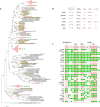Analysis of metagenome-assembled viral genomes from the human gut reveals diverse putative CrAss-like phages with unique genomic features
- PMID: 33594055
- PMCID: PMC7886860
- DOI: 10.1038/s41467-021-21350-w
Analysis of metagenome-assembled viral genomes from the human gut reveals diverse putative CrAss-like phages with unique genomic features
Abstract
CrAssphage is the most abundant human-associated virus and the founding member of a large group of bacteriophages, discovered in animal-associated and environmental metagenomes, that infect bacteria of the phylum Bacteroidetes. We analyze 4907 Circular Metagenome Assembled Genomes (cMAGs) of putative viruses from human gut microbiomes and identify nearly 600 genomes of crAss-like phages that account for nearly 87% of the DNA reads mapped to these cMAGs. Phylogenetic analysis of conserved genes demonstrates the monophyly of crAss-like phages, a putative virus order, and of 5 branches, potential families within that order, two of which have not been identified previously. The phage genomes in one of these families are almost twofold larger than the crAssphage genome (145-192 kilobases), with high density of self-splicing introns and inteins. Many crAss-like phages encode suppressor tRNAs that enable read-through of UGA or UAG stop-codons, mostly, in late phage genes. A distinct feature of the crAss-like phages is the recurrent switch of the phage DNA polymerase type between A and B families. Thus, comparative genomic analysis of the expanded assemblage of crAss-like phages reveals aspects of genome architecture and expression as well as phage biology that were not apparent from the previous work on phage genomics.
Conflict of interest statement
The authors declare no conflict of interest.
Figures







Similar articles
-
Discovery, diversity, and functional associations of crAss-like phages in human gut metagenomes from four Dutch cohorts.Cell Rep. 2022 Jan 11;38(2):110204. doi: 10.1016/j.celrep.2021.110204. Cell Rep. 2022. PMID: 35021085
-
Thousands of previously unknown phages discovered in whole-community human gut metagenomes.Microbiome. 2021 Mar 29;9(1):78. doi: 10.1186/s40168-021-01017-w. Microbiome. 2021. PMID: 33781338 Free PMC article.
-
Biology and Taxonomy of crAss-like Bacteriophages, the Most Abundant Virus in the Human Gut.Cell Host Microbe. 2018 Nov 14;24(5):653-664.e6. doi: 10.1016/j.chom.2018.10.002. Epub 2018 Oct 25. Cell Host Microbe. 2018. PMID: 30449316
-
CrAss-Like Phages: From Discovery in Human Fecal Metagenome to Application as a Microbial Source Tracking Marker.Food Environ Virol. 2024 Jun;16(2):121-135. doi: 10.1007/s12560-024-09584-5. Epub 2024 Feb 27. Food Environ Virol. 2024. PMID: 38413544 Review.
-
The crAss-like Phage Group: How Metagenomics Reshaped the Human Virome.Trends Microbiol. 2020 May;28(5):349-359. doi: 10.1016/j.tim.2020.01.010. Epub 2020 Feb 28. Trends Microbiol. 2020. PMID: 32298613 Review.
Cited by
-
Dynamic nature of viral and bacterial communities in human faeces.iScience. 2023 Dec 29;27(2):108778. doi: 10.1016/j.isci.2023.108778. eCollection 2024 Feb 16. iScience. 2023. PMID: 38292428 Free PMC article.
-
Computational Tools for the Analysis of Uncultivated Phage Genomes.Microbiol Mol Biol Rev. 2022 Jun 15;86(2):e0000421. doi: 10.1128/mmbr.00004-21. Epub 2022 Mar 21. Microbiol Mol Biol Rev. 2022. PMID: 35311574 Free PMC article. Review.
-
Community Types of the Human Gut Virome are Associated with Endoscopic Outcome in Ulcerative Colitis.J Crohns Colitis. 2023 Oct 20;17(9):1504-1513. doi: 10.1093/ecco-jcc/jjad061. J Crohns Colitis. 2023. PMID: 37052201 Free PMC article.
-
Structural atlas of a human gut crassvirus.Nature. 2023 May;617(7960):409-416. doi: 10.1038/s41586-023-06019-2. Epub 2023 May 3. Nature. 2023. PMID: 37138077 Free PMC article.
-
Infant gut DNA bacteriophage strain persistence during the first 3 years of life.Cell Host Microbe. 2024 Jan 10;32(1):35-47.e6. doi: 10.1016/j.chom.2023.11.015. Epub 2023 Dec 13. Cell Host Microbe. 2024. PMID: 38096814 Free PMC article.
References
-
- Hurwitz, B. L., U’Ren, J. M. & Youens-Clark, K. Computational prospecting the great viral unknown. FEMS Microbiol. Lett. 10.1093/femsle/fnw077 (2016). - PubMed
Publication types
MeSH terms
Substances
LinkOut - more resources
Full Text Sources
Other Literature Sources

